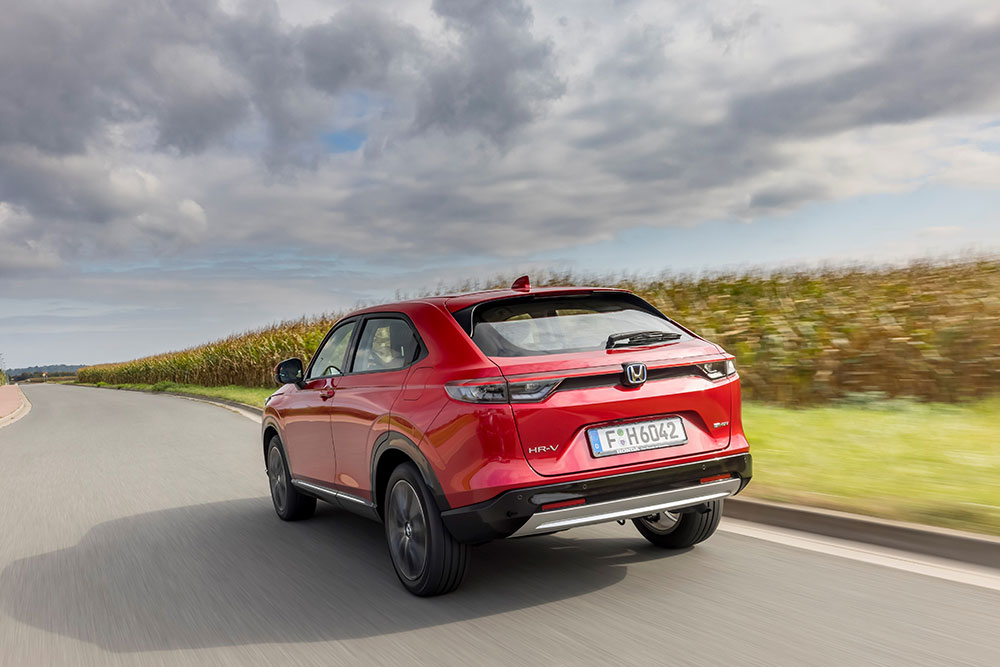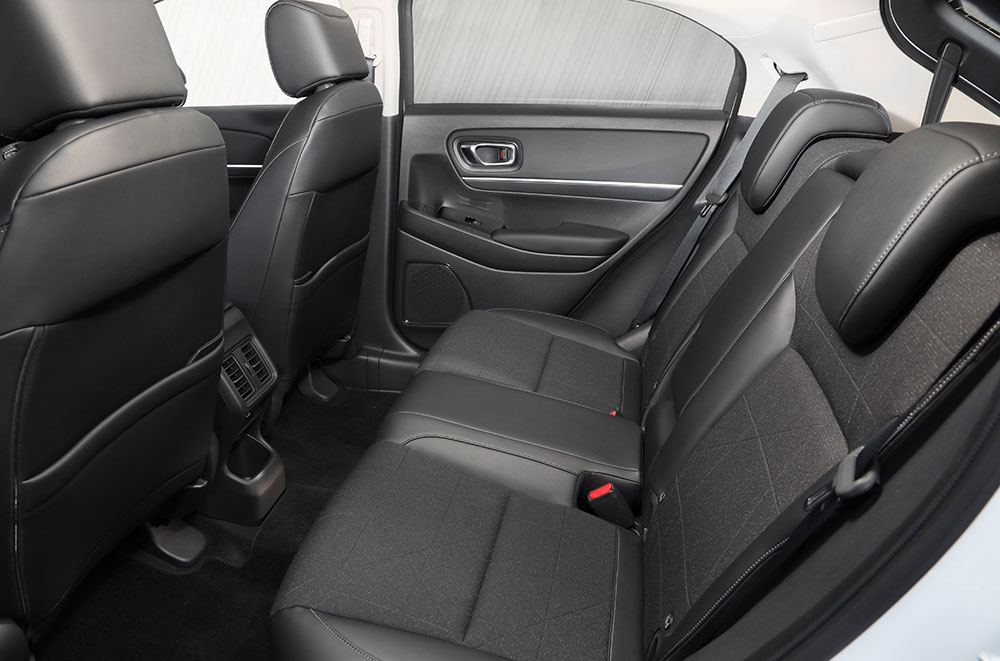New HR-V Hybrid is thriftier but pricier
Honda’s third-generation HR-V small SUV embraces hybrid electric technology plus a more and premium look and feel.
.jpg?h=667&iar=0&w=1000&rev=2ee3bfd707bf41e99a07c62d5e20c3fe&hash=13BFB5C4F193411EC77966A650865D51)
Honda is yet to introduce a fully electric vehicle to the Australian market but its recently launched third-generation HR-V small SUV is its latest model to adopt hybrid electric technology.
The Japanese car maker says the introduction of the hybrid-powered HR-V is the next step in its commitment to introduce hybrid variants of each vehicle line with the arrival of every full model change in Australia.
It’s the first time Honda has made its e:HEV technology available on the HR-V, which also comes with a conventional petrol four-cylinder powertrain.
The entry-level Honda HR-V Vi X grade is powered by a 1.5-litre DOHC i-VTEC petrol engine and costs $36,700 driveaway, while the e:HEV L grade with twin-motor hybrid powertrain costs $45,000 driveaway.
Both models are priced at a premium in a category dominated by the Chinese MG ZS, which starts from a low $21,990 driveaway, while the second best-selling Mazda CX-30 offers a broader 14-model range with a price spread from $29,390 to $47,390 (MRLP).
Mazda has no hybrid offering its CX-30 range, but MG sells the fully electric MG ZS EV Excite for $46,990 driveaway, indicating the Honda will need to offer an especially compelling blend of quality and features to put a dent in the category sales leaders.

The new HR-V certainly puts its best foot forward in the style stakes, with its contemporary coupe-like SUV body striking an attractive pose.
The new model is also claimed to be exceptionally spacious, given its compact exterior dimensions, with a versatile interior layout that Honda says is more user-oriented and comfortable than ever.
The interior design features a modern, minimalist aesthetic and a premium SUV feel with a simple-to-use 9.0-inch touchscreen offering a host of in-car connectivity features such as smartphone mirroring via wireless Apple CarPlay.
Other features include Bluetooth connectivity with audio streaming for compatible devices, DAB+ digital radio, Alps Alpine satellite navigation and more.
In addition to a full suite of airbags, the HR-V e:HEV L comes with a range of advanced driver assistance aids as standard, including collision mitigation braking, lane-keep assist, lane departure warning, road departure mitigation, adaptive cruise control with low-speed follow, blind-spot information system, rear cross-traffic alert, traffic sign recognition and more.
Other features of over the entry-level model include intelligent speed limiter, hands-free power tailgate, auto rain-sensing wipers, heated front seats and a heated leather steering wheel.
The HR-V’s e:HEV powertrain consists of two compact, electric motors working alongside an Atkinson-cycle 1.5-litre DOHC i-VTEC petrol engine, a lithium-ion battery and a fixed-gear transmission coupled to a power control unit.
.jpg?rev=0f0673d2bc6a44d6a5f08a29faca98be&hash=DA402C90CAF0B71EF54877C26879652D)
Honda said the fixed-gear transmission created less friction than a conventional power-split system with a planetary gearbox as used by its rivals, ultimately leading to less energy consumption when driving electrically.
The system also enables a higher proportion of accumulated electric drive time when in stop-start urban driving, and the transfer between drive modes – including the start of the engine to generate electric power – is virtually unnoticeable, according to Honda.
Compared with the Honda Jazz hybrid sold elsewhere, the number of cells in the battery has increased by 25%, allowing greater storage and deployment of electric power.
The power control unit (PCU) has also been downsized and integrated into the engine compartment and is water cooled instead of air cooled, for improved heat management.
Other changes include the gear ratio between the electric motor and wheels being lowered to improve the new HR-V’s dynamic performance.
The HR-V’s Electronic Control Unit automatically and constantly, cycles between electric drive, hybrid drive or engine drive depending on which is the most fuel-efficient drive mode at that specific driving situation, says Honda.

When driving at a constant high speed, such as on the highway, the system operates on engine drive.
If further acceleration is required, such as when overtaking, the car switches to hybrid drive for an additional performance boost.
When in hybrid drive, power from the petrol engine-driven generator can be diverted to recharge the battery, offering additional efficiency benefits.
Drivers can select from three driving modes including ‘Sport’, which sharpens throttle response, ‘Econ’ which adjusts the air conditioning system and throttle response for better fuel efficiency, and ‘Normal’.
They can also select B-range from the transmission, which offers selectable levels of energy recovery when coasting or braking, adjustable via paddles behind the steering wheel.
The hybrid powertrain delivers total outputs of 96kW and 253Nm, which compares with 89kW/145Nm for the internal combustion powered HR-V Vi X. The hybrid’s official fuel consumption rating of 4.3L/100km and CO2 emissions of 98g/km are also thriftier and cleaner than its stablemate’s 5.8L/100km and 133g/km.
When privately operated the new Honda HR-V hybrid is covered by Honda’s five-year unlimited km warranty, five-year premium roadside assistance, and five-year low-price servicing.
Know you're covered with RACQ Comprehensive Car Insurance
Related topics
Things to note
The information in this article has been prepared for general information purposes only and is not intended as legal advice or specific advice to any particular person. Any advice contained in the document is general advice, not intended as legal advice or professional advice and does not take into account any person’s particular circumstances. Before acting on anything based on this advice you should consider its appropriateness to you, having regard to your objectives and needs.
Insurance Products (excluding Travel Insurance) are issued by RACQ Insurance Limited ABN 50 009 704 152 (RACQI) and arranged by its agent, RACQ Distribution Services Pty Ltd (RDS) ABN 35 116 361 650, AFSL 567130 and RDS' authorised representatives (including RACQ Operations Pty Ltd ABN 80 009 663 414, AR No. 234978 (RACQO). Conditions, limits and exclusions apply. RDS and RACQO are in the RACQ group of companies. One of the companies in the RACQ group of companies has a minority shareholding in RACQI.
RDS and RACQO have not taken your personal objectives, circumstances or needs into account when preparing advice regarding insurance products and you will need to consider whether the advice is appropriate for you. Read the Product Disclosure Statement (PDS) and any applicable Supplementary PDS before making a purchase decision on this product. You can also access our Target Market Determinations on this website. RDS receives a commission from RACQI for the policies it arranges. RACQO receives fees paid for services it provides to RDS. Further details about remuneration are available on request prior to purchasing.
Banking and loan products issued by Members Banking Group Limited ABN 83 087 651 054 AFSL/Australian credit licence 241195 trading as RACQ Bank. Terms, conditions, fees, charges and lending policies apply. This is general advice only and may not be right for you. This information does not take your personal objectives, circumstances or needs into account. Read the disclosure documents for your selected product or service, including the Financial Services Guide and the Terms and Conditions, and consider if appropriate for you before deciding.
Except for RACQ Bank, any RACQ entity referred to on this page is not an authorised deposit-taking institution for the purposes of the Banking Act 1959 (Cth). That entity’s obligations do not represent deposits or other liabilities of RACQ Bank. RACQ Bank does not guarantee or otherwise provide assurance in respect of the obligations of that entity, unless noted otherwise.
RACQ Bank subscribes to the Customer Owned Banking Code of Practice which establishes higher standards than the law requires. The Code reflects modern consumer expectations and developments in approaches to issues such as consumer vulnerability, guarantors, and supporting customers through financial hardship. Please read our Customer Owned Banking Code of Practice page for more information.
RACQ Operations Pty Ltd (ABN 80 009 663 414 AR 000234978) and Members Travel Group Pty Ltd (ABN 45 144 538 803 AR 000432492) are acting as an Authorised Representative of the issuer of the insurance, Tokio Marine & Nichido Fire Insurance Co., Ltd. (ABN 80 000 438 291 AFSL 246 548). Any advice set out above is general in nature only, and does not take into account your objectives, financial situation or needs. Before purchasing any travel products, please consider the RACQ Travel Insurance Product Disclosure Statement (PDS) and the Target Market Determinations (TMDs) that apply to these products. Whilst the PDS outlines the Terms and Conditions of these products, the TMDs outline the intended class of customers that comprise the target market for these travel products. This will allow you to consider which products best suit your objectives, financial situation and needs and consider the products appropriateness to your personal circumstances. TMDs also outline matters involving the distribution and the review of these products. The PDS, Supplementary PDS and TMDs for each travel product can be found here.
